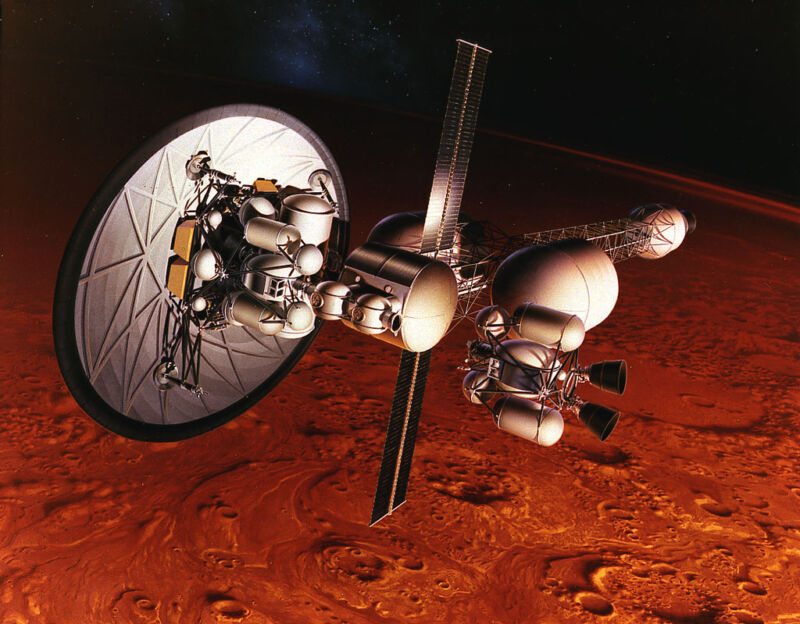Report: NASA’s Only Realistic Path for Humans On Mars Is Nuclear Propulsionhttps://arstechnica.com/science/2021/02/report-nasas-only-realistic-path-for-humans-on-mars-is-nuclear-propulsion/
... NASA has a couple of baseline missions for sending four or more astronauts to Mars, but relying on chemical propulsion to venture beyond the Moon probably won't cut it. The main reason is that it takes a whole lot of rocket fuel to send supplies and astronauts to Mars. Even in favorable scenarios where Earth and Mars line up every 26 months, a humans-to-Mars mission still requires 1,000 to 4,000 metric tons of propellant.
If that’s difficult to visualize, consider this. When upgraded to its Block 1B configuration, NASA’s Space Launch System rocket will have a carrying capacity of 105 tons to low-Earth orbit. NASA expects to launch this rocket once a year, and its cost will likely be around $2 billion for flight. So to get enough fuel into orbit for a Mars mission would require at least 10 launches of the SLS rocket, or about a decade and $20 billion. Just for the fuel.
The bottom line: if we’re going to Mars, we probably need to think about other ways of doing it.
Going nuclearA new report from the National Academies of Sciences, Engineering, and Medicine offers some answers about two such ways. Conducted at the request of NASA, a broad-based committee of experts assessed the viability of two means of propulsion—nuclear thermal and nuclear electric—for a human mission launching to Mars in 2039.
Report: https://www.nap.edu/catalog/25977/space-nuclear-propulsion-for-human-mars-exploration"One of the primary takeaways of the report is that if we want to send humans to Mars, and we want to do so repeatedly and in a sustainable way, nuclear space propulsion is on the path," said Bobby Braun, director for planetary science at the Jet Propulsion Laboratory and co-chair of the committee that wrote the report, in an interview.
The committee was not asked to recommend a particular technology, each of which rely on nuclear reactions but work differently. Nuclear thermal propulsion (NTP) involves a rocket engine in which a nuclear reactor replaces the combustion chamber and burns liquid hydrogen as a fuel. Nuclear electric propulsion (NEP) converts heat from a fission reactor to electrical power, like a power plant on Earth, and then uses this energy to produce thrust by accelerating an ionized propellant, such as xenon.
Nuclear propulsion requires significantly less fuel than chemical propulsion, often less than 500 metric tons. That would be helpful for a Mars mission that would include several advance missions to pre-stage cargo on the red planet. Nuclear propulsion's fuel consumption is also more consistent with the launch opportunities afforded by the orbits of Earth and Mars. During some conjunctions, which occur about every 26 months, the propellant required to complete a Mars mission with chemical propellants is so high that it simply is not feasible.
... SpaceX engineers know it will take a lot of fuel to reach Mars, but they believe the problem is solvable if Starship can be built to fly often and for relatively little money. The basic concept is to launch a Starship to orbit with empty tanks and transfer fuel launched by other Starships in low-Earth orbit before a single vehicle flies to Mars.
Braun said SpaceX is developing a plan to send humans to Mars with different assumptions than NASA. "I think there's a fundamental difference in the assumptions that NASA tends to make for what kind of infrastructure is needed at Mars," he said.
That's not to say Starship cannot work. However, it does illustrate the challenge of mounting a mission to Mars with chemical-only propulsion.
To use traditional propulsion, one needs to push the boundaries of reuse and heavy lift rockets to extreme limits—which is precisely what SpaceX is trying to do with its fully reusable launch system.
